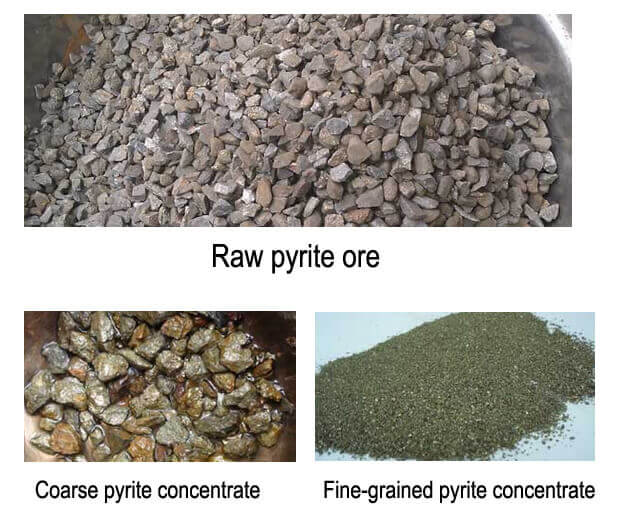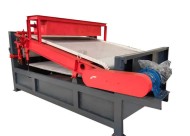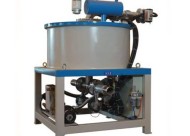Iron ore desulfurization is the process of removing sulfur from iron ore that contains sulfur compounds. Sulfur is a common impurity in iron ore, and the presence of sulfur compounds can adversely affect the ironmaking process and product quality. Therefore, desulfurization is an essential link in the iron ore pretreatment process.
Iron Ore Desulfurization Methods
The desulphurization of iron ore mainly improves its quality and reduces environmental emissions during subsequent processing. There are many methods and processes for iron ore desulfurization, including:
Magnetic separation
This magnetic separation utilizes magnetic properties to separate sulfur-bearing minerals from iron ore. The ore is subjected to a magnetic field, and the sulfur-bearing minerals are attracted to the magnetic surface while the iron ore particles remain unaffected. The separated sulfur-bearing minerals can be further processed or discarded.
Flotation
Flotation is a commonly used technique for desulfurizing iron ore. In this process, finely ground ore is mixed with water and chemicals, such as collectors and frothers. Air is then bubbled through the mixture, causing the sulfur-bearing minerals to attach to the air bubbles and rise to the surface as froth, while the iron ore particles sink to the bottom. The froth containing sulfur can be removed, leaving behind desulfurized iron ore.
Roasting
Roasting involves heating the iron ore at high temperatures in the presence of air or oxygen. This process oxidizes the sulfur in the ore, converting it into sulfur dioxide gas (SO2) or other sulfur compounds, which can be easily separated from the iron ore. Roasting can occur in a rotary kiln, fluidized bed reactor, or other suitable equipment.
Biological desulfurization
Biological methods involve using microorganisms to remove sulfur from iron ore selectively. Certain bacteria or fungi can oxidize the sulfur compounds in the ore, converting them into soluble forms that can be washed away. Biological desulfurization is an environmentally friendly approach, but it is still under development and has yet to be widely used on an industrial scale.
Hydrometallurgical processes
Hydrometallurgical methods use chemical leaching agents to dissolve and remove sulfur from iron ore. One example is the acid-leaching process, where the ore is treated with an acid solution that selectively dissolves the sulfur minerals. The leaching solution is then separated from the solid residue containing desulfurized iron ore.
Combination methods
Various combinations of the above methods can be employed to achieve effective desulfurization, depending on the specific characteristics of the iron ore and the desired sulfur removal efficiency.
The selection of the desulfurization method depends on factors such as the sulfur content and mineralogy of the iron ore, the desired sulfur removal efficiency, the economic viability of the process, and environmental considerations. Different iron ore deposits may require different desulfurization approaches. Therefore, it is essential to conduct thorough testing and evaluation to determine the most suitable method for a particular ore.
Iron Ore Desulfurization Processes
The iron ore desulfurization process of pyrrhotite, pyrite-associated iron ore, includes grinding, desulfurization, magnetic separation-flotation combined desulfurization process, and roasting-magnetic separation-flotation combined desulfurization process.
- Iron ore with fine particle size and single sulfur content: It is suitable for adopting grinding and desulfurization processes;
- Strongly magnetic iron ores containing various types of sulfur: The magnetic separation-flotation combined desulfurization process is suitable;
- Weakly magnetic iron ores containing various types of sulfur: The roasting-magnetic separation-flotation combined desulfurization process is suitable.
Associated Iron Ore Desulfurization And Iron Separation Technology
1. Stage grinding, stage separation, desulfurization, and iron separation process
Grinding fineness significantly influences mineral processing indicators. Products with different grinding fineness have different particle size compositions, thus affecting minerals’ monomer dissociation and selectability. Fine-grained iron ore requires Fine grinding to dissociate the mineral monomers. For iron ore with finer particle size and a single sulfur-containing type (pyrite and pyrrhotite), stage grinding and stage separation processes are usually used to increase iron and reduce sulfur.
2. Magnetic separation-flotation combined desulfurization and iron separation process
The magnetite currently selected in China contains a large amount of pyrrhotite and pyrite due to its fine particle size, which makes the negative impact of magnetic agglomeration in the separation very obvious. It is increasingly difficult to improve the concentrate grade by relying on a single magnetic separation method. Combining magnetic separation with anion reverse flotation can achieve complementary advantages in the process of magnet ore separation, which is beneficial to improving the grade of magnet ore separation concentrate. The magnetic separation-flotation combined process is one of the more effective processes for increasing iron and reducing sulfur in high-pyrite iron ore in China.
3. Roasting-magnetic separation-flotation combined desulfurization process
The reduction roasting magnetic separation process of domestic iron ore has not been widely used due to the high cost and low grade of iron concentrate. This process is mainly suitable for iron ores with significant burning losses, such as limonite and siderite. For weakly magnetic iron ore with low theoretical grade and various sulfur-containing types, iron ore concentrate with low impurity content can be obtained through a combined roasting-magnetic separation-flotation process, significantly improving product quality.
After iron ore is desulfurized, the economic benefits are significant. By reducing the sulfur content in the ore, iron grade and recovery rate are improved, making the production process more efficient and product quality more stable. In addition, desulfurized iron ore is more accessible to process and utilize, reducing production costs and energy consumption. At the same time, the desulfurization process also helps reduce environmental pollution, meets environmental protection standards, and enhances the company’s social image. The application of associated iron ore desulfurization technology has brought obvious economic and environmental benefits to enterprises.
LATEST PRODUCTS
Heavy Plate Feeder
Capacity: 100-240 m3/h Power: 15-45 kW Speed: 0…
Plate Magnetic Separator
【Capacity】8-35 t/h 【Power】1.5-3 kW 【Applic…
Slurry Magnetic Separator
【Capacity】10-100 m3/h 【Feeding Material Densi…










